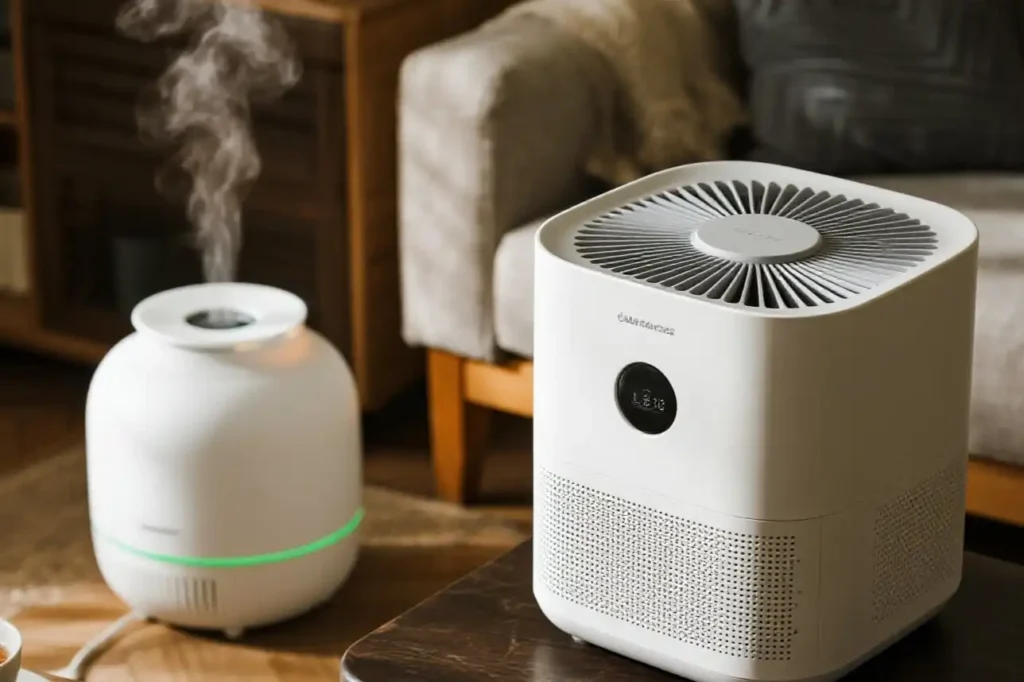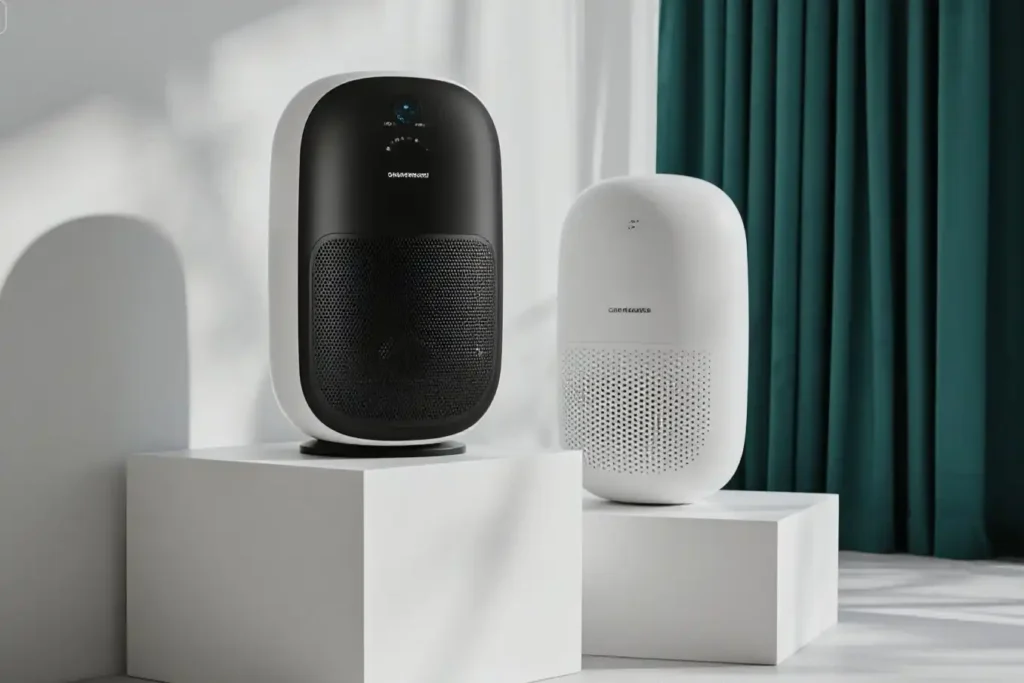
If you’re concerned about managing asthma or allergy symptoms at home, you’re not alone. Many people wonder if an air purifier and humidifier can help. These devices serve different purposes but can complement each other. An air purifier removes dust, allergens, smoke, and other pollutants from the air, while a humidifier adds moisture to dry air, making it easier to breathe. Here’s a breakdown of their main features:
| Aspect | Air Purifier | Humidifier |
|---|---|---|
| Primary Function | Remove dust, allergens, smoke, pet dander, and germs from the air using filters like HEPA, activated carbon, UV light, or ionizers. | Add moisture to dry air to maintain proper humidity levels. |
| Health Impact | Help reduce allergy and asthma symptoms, improve breathing, decrease secondhand smoke exposure, and promote better sleep. | Relieve dry skin, stuffy nose, and breathing issues caused by dry air. |
| Air Quality Effect | Clean the air by eliminating harmful particles. | Do not purify the air but improve comfort by increasing humidity. |
| Suitable Conditions | Ideal for environments with polluted air, allergy sufferers, smokers, and asthma patients. | Best for dry climates, cold seasons, and rooms with low humidity. |
| Maintenance | Require regular filter changes and cleaning to maintain effectiveness. | Need frequent cleaning to prevent mold and bacteria growth. |
| Combined Use | Using an air purifier and humidifier together can enhance air quality and comfort. | Using an air purifier and humidifier together can enhance air quality and comfort. |
| Clinical Study Citation | No recent clinical studies, but health benefits align with medical knowledge. | No recent clinical studies, but health benefits align with medical knowledge. |
Understanding these differences can help you choose the right air purifier and humidifier for your needs.
Key Takeaways
- Air purifiers take out allergens like dust, pollen, and pet dander with HEPA filters. This helps lower asthma and allergy problems.
- Humidifiers put water into dry air. This helps with dry skin, sore throats, and trouble breathing. But humidifiers do not clean the air.
- Keep indoor humidity between 30% and 50%. This stops mold and dust mites. Mold and dust mites can make asthma and allergies worse.
- Clean and take care of air purifiers and humidifiers often. This stops mold, bacteria, and keeps them working well.
- Do not use air purifiers that make ozone, like ionizers. Ozone can hurt your lungs and make asthma worse.
Air Purifier and Humidifier Basics

Key Differences
You might wonder how an air purifier and humidifier are different. Each one helps your home in its own way. An air purifier takes out dust, pollen, pet dander, and smoke from the air. It uses filters like HEPA or activated carbon to catch small things that can bother people with allergies or asthma. A humidifier does something else. It puts water into the air to make it less dry. It does not clean the air but helps when the air feels dry, like in winter or dry places.
Tip: To pick the right device, think about your main issue. If you have allergies or asthma from dust or pollen, an air purifier may help you most. If dry air gives you a sore throat or dry skin, a humidifier can help you feel better.
| Device | Core Function | Health Benefits and Effects |
|---|---|---|
| Air Purifier | Takes out things like smoke, pollen, pet hair, and dust using HEPA or activated carbon filters. | Makes indoor air better by lowering allergens and irritants; lowers the chance of getting sick from things like the common cold, flu, and COVID-19. |
| Humidifier | Puts water into the air to make it less dry using evaporative wicks or ultrasonic technology. | Helps with problems from dry air like dry skin, stuffy nose, and sore throat; makes it harder for the flu virus to spread; soothes asthma and allergy symptoms; helps people sleep better, especially those who use CPAP machines. |
How They Help Asthma and Allergies
Both devices can help you breathe better, but they work in different ways.
- Air purifiers catch things like dust, mold, and pet dander. This can lower asthma triggers and help you breathe easier. Some studies say using an air purifier with a HEPA filter may help lower asthma and allergy symptoms, especially if you also keep your home clean.
- Humidifiers do not take out allergens, but they add water to the air. This can help dry noses and throats feel better and make breathing easier. The right amount of humidity may also make viruses not last as long in the air.
- You must keep both devices clean. If a humidifier gets dirty, mold or bacteria can grow and make asthma or allergies worse. Air purifiers need new filters often to keep working well.
Note: Using an air purifier and humidifier together can give you cleaner air and better humidity. This may help you control your symptoms more easily.
Air Purifiers for Allergies and Asthma

HEPA Filters and Effectiveness
HEPA filters are important for people with allergies and asthma. These filters catch tiny things that can make you feel sick. Many air purifiers for homes use HEPA filters. They work by pushing air through a thin net. This net traps dust, pollen, pet dander, and some germs.
Tests in labs show HEPA filters take out most common allergens in the air. The table below shows how well HEPA filters remove different allergens:
| Allergen Type | Removal Efficiency (%) |
|---|---|
| Airborne particles (all size fractions) | 67 – 92.4 |
| Der f 1 (house dust mite allergen) | 75.2 |
| Fel d 1 (cat allergen) | 76.6 |
| Can f 1 (dog allergen) | 89.3 |
Studies show HEPA filter air purifiers help lower allergy and asthma symptoms. One study found using a HEPA filter in the bedroom for eight weeks cut airborne particles by 70%. People in the study had fewer symptoms, especially if they did not have a cold. Other research says using HEPA air cleaners in both the bedroom and living room helps control asthma better. You might sleep better and feel better, even if your lungs do not change much.
Tip: Put your HEPA air purifier near your bed or where you spend lots of time. This helps you get the cleanest air.
Ionizers and Ozone Risks
Some air purifiers use ionizer technology instead of HEPA filters. Ionizers charge particles in the air so they stick to things or each other. But ionizers make ozone as a side effect. Ozone is a gas that can hurt your lungs and make breathing harder.
The Environmental Protection Agency and health groups say not to use ionizer air purifiers if you have asthma or allergies. Ozone can make you cough, hurt your chest, make it hard to breathe, and irritate your throat. It can also make asthma worse and make it harder for your body to fight sickness. Kids, older people, and those with lung problems are at higher risk.
| Health Risks from Ozone Exposure | Description |
|---|---|
| Lung function decrease | Ozone can make your lungs work less well. |
| Aggravation of asthma | Ozone makes asthma symptoms worse. |
| Throat irritation and cough | Ozone can make your throat sore and cause coughing. |
| Chest pain and shortness of breath | Ozone can make your chest hurt and breathing hard. |
| Lung tissue inflammation | Ozone can make your lungs swell and get damaged. |
| Increased susceptibility to respiratory infections | Ozone makes it easier to get sick in your lungs. |
Alert: Ionizer and ozone generator air purifiers are not safe for people with asthma or allergies. Pick a purifier with a HEPA filter and check for trusted certifications.
Maintenance Tips
To keep your air purifier working, you must take care of it. Clean or change filters as the maker says. If you use a HEPA filter, most brands say to replace it every 6 to 12 months. In places with lots of pollution or during allergy season, you may need to change filters more often. Some purifiers have lights or signs to tell you when to change the filter.
| Filter Type | Recommended Replacement Frequency |
|---|---|
| Pre-filters | Every 2–3 months (replace or clean) |
| Main HEPA filters | About every 12 months |
| Activated carbon filters | Every 3–6 months |
If you do not take care of your air purifier, problems can happen:
| Consequence | Explanation |
|---|---|
| Reduced Airflow and Efficiency | Dirty filters block air and make the system work harder. |
| Poor Indoor Air Quality | Dirty filters let more allergens and dust into the air. |
| System Overload and Breakdowns | Too much strain can make the purifier break. |
| Decreased Lifespan | Dirt can wear out the purifier faster. |
| Increased Energy Costs | A clogged filter uses more energy and costs more money. |
Note: Do not wait until filters look dirty. Change them on time to keep your air purifier working and your air clean.
Humidifiers and Respiratory Health
Steam vs. Other Types
Steam humidifiers are also called vaporizers. They heat water until it turns into steam. This kills most germs, mold, and allergens in the water. The steam goes into your air as clean moisture. Cool mist and ultrasonic humidifiers do not use heat. They may not kill germs or allergens. Steam humidifiers help stop bacteria and allergens from spreading at home. The American Academy of Allergy, Asthma, and Immunology says steam vaporizers are good for people with allergies. They let out fewer bad things into the air.
Other humidifiers work in different ways. Ultrasonic humidifiers use vibrations to make a fine mist. This mist can carry minerals and bacteria from the water. It may cause white dust or breathing problems, especially for kids. Evaporative humidifiers use a fan and a wick filter to add moisture. The filter catches some bad stuff, but you need to change it often to keep the air clean.
| Type | How It Works | Air Quality Impact | Safety Notes |
|---|---|---|---|
| Steam (Vaporizer) | Boils water to make steam | Releases clean, germ-free steam | Hot steam can cause burns |
| Ultrasonic | Vibrates water to create cool mist | May spread minerals and bacteria | No burn risk, but white dust risk |
| Evaporative | Fan blows air through wet wick/filter | Traps some impurities | Needs regular filter changes |
Tip: Steam humidifiers give the cleanest moisture. Keep them away from children to prevent burns.
Humidity Levels and Risks
You want your home to feel nice, but too much moisture is not good. Doctors say to keep indoor humidity between 30% and 50%. This stops dust mites and mold from growing. If humidity is over 50%, dust mites and mold can grow fast. These can make asthma and allergy symptoms worse.
- Dust mites like moist air. Keeping humidity under 50% helps control them.
- Mold grows quickly in damp places. Humidity over 60% helps mold spread.
- Too much moisture can cause wet spots on walls and windows. This can lead to mold and bacteria.
Use a hygrometer to check humidity if you use a humidifier. If you see water on windows or walls, move the humidifier or turn it down. Use a dehumidifier or air conditioner in summer or when it rains to keep moisture low.
Note: Breathing air with too much moisture can bother your lungs. This is a bigger problem for kids, older people, and those with asthma.
Cleaning and Water Choice
It is important to keep your humidifier clean. Dirty humidifiers can spread mold, bacteria, and minerals into the air. These things can make allergies or asthma worse. Distilled water is best to use. It has almost no minerals or germs. This keeps your humidifier cleaner and lowers white dust.
Follow these steps to keep your humidifier safe:
- Empty and refill the tank every day with fresh distilled water.
- Clean all parts that touch water at least twice a week. Use white vinegar or hydrogen peroxide to clean off buildup.
- Rinse all parts well after cleaning to get rid of cleaner.
- Dry all parts before putting the humidifier back together.
- Change filters and wicks as the maker says.
- Look for mold or slime. If you see any, clean the humidifier right away.
Alert: Do not use tap water in your humidifier if you have allergies or asthma. Tap water can have minerals and bacteria that may get into your air.
A clean humidifier and the right water help you breathe better and keep your home healthy. Taking care of your humidifier also helps it last longer.
Using Air Purifier and Humidifier Together
Best Practices
Using both an air purifier and humidifier at home can help with asthma and allergies. Each device helps with a different problem. The air purifier takes out dust, pollen, and other allergens from the air. The humidifier puts moisture in the air. This helps stop dry skin and makes your throat feel better. When you use both, you make the air cleaner and more comfortable. This is helpful in winter when heaters dry out the air and stir up allergens.
Experts say using both is a good idea. It helps keep the air clean and comfy. The air purifier and humidifier work together to lower triggers and make your home feel fresh. You may feel better than if you only use one. You might have fewer symptoms, sleep better, and feel more comfortable.
Tip: Always keep both devices clean. Change filters and clean them often. This stops mold and bacteria from growing.
Placement and Monitoring
Where you put your air purifier and humidifier is important. Put them on different sides of the room. This keeps the humidifier’s moisture away from the air purifier’s filters. It helps both machines last longer. Put the air purifier near where you spend the most time, like by your bed or chair. Make sure nothing blocks the air going in or out.
Keep the air in your home between 30% and 50% humidity. This stops mold and dust mites from growing. Use a hygrometer or smart monitor to check humidity and air quality. Devices like PrimoAire’s Home Air Quality Monitor or Airthings sensors can track dust, pollen, mold, and humidity. These tools help you find problems early and fix them.
- Put the humidifier and air purifier on different sides of the room.
- Use a monitor to check air quality and humidity.
- Keep the air purifier away from walls and furniture.
- Clean both machines often to stop bacteria and mold.
Setting up your air purifier and humidifier the right way helps everyone in your home breathe easier and feel safe.
Picking the best air purifier and humidifier can help with asthma and allergies at home. HEPA filters can take out almost 90% of allergens in the air. Keeping humidity between 30% and 50% stops mold and dust mites from growing.
- Make sure you clean your devices often.
- Do not use machines that make ozone.
- Choose a device that fits your room size.Always ask your doctor for advice that is right for you. Better air in your home can help you breathe easier and feel good every day.
FAQ
What is the best type of air purifier for allergies?
Pick an air purifier that has a true HEPA filter. HEPA filters catch tiny things like dust, pollen, and pet dander. Do not use ionizers because they can make ozone. Ozone can make asthma or allergies worse.
What humidity level should you keep for asthma and allergies?
Keep your home’s humidity between 30% and 50%. This stops mold and dust mites from growing. Use a hygrometer to check the humidity in your house.
What happens if you do not clean your humidifier?
If you do not clean your humidifier, it can spread mold, bacteria, and minerals into the air. This can make asthma or allergy symptoms worse. Clean your humidifier often to keep the air safe.
What size air purifier or humidifier do you need?
Choose a device that fits the size of your room. Look at the product label to see what size room it covers. Using the right size helps the device work well and keeps your air healthy.
See also
Things to Consider Before Buying an AQI Sensor Air Purifier with Display
The benefits of air purifiers for illness prevention and health improvement
